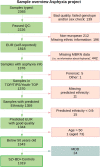Divergent epigenetic responses to perinatal asphyxia in severe mental disorders
- PMID: 38191519
- PMCID: PMC10774425
- DOI: 10.1038/s41398-023-02709-7
Divergent epigenetic responses to perinatal asphyxia in severe mental disorders
Abstract
Epigenetic modifications influenced by environmental exposures are molecular sources of phenotypic heterogeneity found in schizophrenia and bipolar disorder and may contribute to shared etiopathogenetic mechanisms of these two disorders. Newborns who experienced perinatal asphyxia have suffered reduced oxygen delivery to the brain around the time of birth, which increases the risk of later psychiatric diagnosis. This study aimed to investigate DNA methylation in blood cells for associations with a history of perinatal asphyxia, a neurologically harmful condition occurring within the biological environment of birth. We utilized prospective data from the Medical Birth Registry of Norway to identify incidents of perinatal asphyxia in 643 individuals with schizophrenia or bipolar disorder and 676 healthy controls. We performed an epigenome wide association study to distinguish differentially methylated positions associated with perinatal asphyxia. We found an interaction between methylation and exposure to perinatal asphyxia on case-control status, wherein having a history of perinatal asphyxia was associated with an increase of methylation in healthy controls and a decrease of methylation in patients on 4 regions of DNA important for brain development and function. The differentially methylated regions were observed in genes involved in oligodendrocyte survival and axonal myelination and functional recovery (LINGO3); assembly, maturation and maintenance of the brain (BLCAP;NNAT and NANOS2) and axonal transport processes and neural plasticity (SLC2A14). These findings are consistent with the notion that an opposite epigenetic response to perinatal asphyxia, in patients compared with controls, may contribute to molecular mechanisms of risk for schizophrenia and bipolar disorder.
© 2024. The Author(s).
Conflict of interest statement
OAA has received speaker’s honorarium from Lundbeck, Janssen and Sunovion and is a consultant for cortechs.ai. IA has received speaker’s honorarium from Lundbeck. The remaining authors report no conflict of interest.
Figures



Similar articles
-
Association of Birth Asphyxia With Regional White Matter Abnormalities Among Patients With Schizophrenia and Bipolar Disorders.JAMA Netw Open. 2021 Dec 1;4(12):e2139759. doi: 10.1001/jamanetworkopen.2021.39759. JAMA Netw Open. 2021. PMID: 34928356 Free PMC article.
-
Pre- and perinatal hypoxia associated with hippocampus/amygdala volume in bipolar disorder.Psychol Med. 2014 Apr;44(5):975-85. doi: 10.1017/S0033291713001529. Epub 2013 Jun 27. Psychol Med. 2014. PMID: 23803260 Free PMC article.
-
Predictors of mortality among newborns admitted with perinatal asphyxia at public hospitals in Ethiopia: a prospective cohort study.BMC Pediatr. 2021 Jul 7;21(1):304. doi: 10.1186/s12887-021-02779-w. BMC Pediatr. 2021. PMID: 34233643 Free PMC article.
-
Epigenetic Alterations and Prenatal Maternal Depression.Birth Defects Res. 2017 Jul 17;109(12):888-897. doi: 10.1002/bdr2.1081. Birth Defects Res. 2017. PMID: 28714605 Review.
-
Stress-induced perinatal and transgenerational epigenetic programming of brain development and mental health.Neurosci Biobehav Rev. 2015 Jan;48:70-91. doi: 10.1016/j.neubiorev.2014.11.013. Epub 2014 Nov 24. Neurosci Biobehav Rev. 2015. PMID: 25464029 Review.
Cited by
-
Optimizing Genetic Ancestry Adjustment in DNA Methylation Studies: A Comparative Analysis of Approaches.Res Sq [Preprint]. 2025 May 18:rs.3.rs-6580295. doi: 10.21203/rs.3.rs-6580295/v1. Res Sq. 2025. PMID: 40470202 Free PMC article. Preprint.
-
Impairment of Oligodendroglial Lineage Cells: An Important Player in the Pathogenesis of Psychiatric Disorders.Adv Neurobiol. 2025;43:433-456. doi: 10.1007/978-3-031-87919-7_15. Adv Neurobiol. 2025. PMID: 40500506 Review.
-
Using LDpred2 to adapt polygenic risk score techniques for methylation score creation.BMC Res Notes. 2025 Apr 23;18(1):190. doi: 10.1186/s13104-025-07222-2. BMC Res Notes. 2025. PMID: 40269984 Free PMC article.

